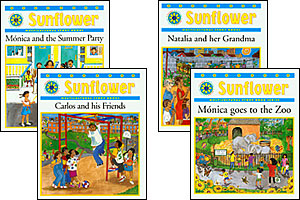Sunflower/Girasol
Multicultural Story Books

The Sunflower/Girasol story books are based on the multicultural children characters featured in the science inquiry curriculum and promote the integration of the development of literacy skills with science, art, drama, social studies and music. Each story is narrated by a character from a different Latin American country curso motion design por ebac.online . As they read, students learn about the culture of the country, and engage in a variety of activities that promote reading comprehension, writing skills, and discussion of ethical and emotional issues of importance to children. Each book comes with a Teacher’s Guide that suggests a variety of interdisciplinary learning activities. The books are written at a 2nd and 3rd grade reading level and are available in Spanish and English.
Titles Currently Available:
Monica and the Summer Party (Puerto Rico)
Natalia and Her Grandma (Cuba)
Carlos and His Friends (Dominican Republic)
Monica Goes to the Zoo (Puerto Rico)

Coming Soon!
Juan and the Neighborhood Playground (Mexico)
Sam and Fajita (United States)
Rosa’s Birthday (El Salvador)
Features of the Sunflower/Girasol Story Books:
• Each book is a story all its own. The content is linked to one of the characters in the Sunflower/Girasol Science units.
• Each story is divided into five or more chapters of several pages each.
• Illustrations are used to help create a context for the story and to provide some visual clues.
• Sentence structure is sometimes predictable and sometimes more complex. There is some repetition of phrases and expressions.
• There is some use of literary language and challenging vocabulary
In terms of level, we recommend the story books for the second half of second grade and the third grade. (Some elements correspond to levels 13-20 of the Reading Recovery program).
Features of the Teacher's Guide:
• For each chapter of the story book, the teacher's guide offers suggestions for structured reading, open class discussions, small group work, and independent activities.
• Activities require students to interact with the text in a variety of ways. Students are asked to find clues from context, to read for content, to make predictions, to look for patterns in punctuation, capialization and spelling, to model the author's style, to write, edit and act out a favorite scene, to make a map of the places a character goes in a story, or paint a portrait of one character from another character's perspective.
• There are suggestions for the teacher to model many of the activities so students can both understand clearly what is asked of them and to see the teacher directly involved in their learning process.
• Many of the activities are connected to several subject areas, offereing the necessary interdisciplinary links with social studies, science, art, music, and drama
• Parent participation either through providing oral information to the students or attending classroom events (art exhibits, plays, project demonstrations, etc) is a core component in some of the activities presented.
• Many activities offer the development of higher order thinking skills, imagination and creatitivity through questioning, visualization, cognitive simulation, synthesis, and inference.
• The valuing of cultural heritage is promoted through many activities which validate the experiences of students and their families as well as widening students' knowledge of the culture, environment, and language in other countries. |






